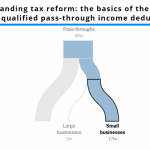Modifications to Popular Pass-through Tax Break Has Many High Earner Businesses Puzzled
 A clause in the Tax Cuts and Jobs Act (TCJA) concerning a key deduction, the taxation of pass-through income, is causing uproar and confusion among businesses, taxation advisors and high-earners. The new complex rules and regulations for such income “is as clear as mud.”
A clause in the Tax Cuts and Jobs Act (TCJA) concerning a key deduction, the taxation of pass-through income, is causing uproar and confusion among businesses, taxation advisors and high-earners. The new complex rules and regulations for such income “is as clear as mud.”
Tax advisors and designated CPAs are at a loss when asked how the TCJA’s new federal law regarding pass-through income will impact businesses and business owners. This lack of comprehension is well warranted as the details and guidelines for business owners with high incomes, particularly when such income is derived via pass-through revenue, is nothing short of vague. Earners with income derived from companies qualifying as pass-through firms report their income on their individual taxes, as opposed to including that income on their business’ corporate returns.
Background
The TCJA’s is full of safeguards created to prevent high-earners from reporting labor income as business income. Essentially, caveats in the new law put a cap on the amount of income that can be considered and allowed to be designated pass-through generated and subsequently taxed at the pass-through rate of 20 percent instead of being taxed at an individual’s designated rate, which is very likely to exceed 20 percent.
As included in the broader restructuring of tax regulations, Congress passed a tax bill in which a 20 percent deduction for owners of pass-through businesses was permitted. Defined as pass-through firms are those businesses structured as limited liability companies, S corporations, partnerships and sole proprietorships. The implemented and enacted TCJA tax break essentially reduces pass-through business owners subject to a top rate of 29.6 percent, which is a large reduction considering that those owners have been customarily taxed at 39.6 percent before the new tax code was put into motion.
According to the most recent surveys, business owners filed for $34.4 million in pass-through returns. The Joint Committee on Taxation predicts that pass-throughs account for 40.6 percent of net income reported by companies. The pass-through deduction dollar figure can be claimed by any and all business owners with taxable incomes up to $315,000. Above that amount, the phasing out of the pass-through tax break will be $100,000 of income for owners of service business. Of note is the existence of entirely separate restrictions linked to capital investment and wages levels paid.
Pass-through Income Requirements
In an attempt to assuage concerns regarding the TCJA’s pass-through specifications, legislators have included a deduction of up to 20 percent for pass-through entities on “qualified business income” (QBI); QBI is, of course, also subject to certain limits and restrictions. QBI is defined as net income from a company less counting amounts in the nature of compensation. Also excluded from QBI investment income is that income derived from a pass-through entity. Of note is that QBI is determined on a case-by-case basis for each business activity, instead of determined on a per-taxpayer basis.
Two important hurdles exist if for 20 percent deduction to be successfully claimed. In essence, the break a business receives may be reduced, or even completely eliminated, under a test for “wage and capital” limits and how “specified service businesses” are recognized. Let’s look at these two clauses more closely:
- Wage and Capital Limit: The pass-through deduction begins to diminish when two tests are not passed. Essentially, the deduction is limited to the greater of (a) 50 percent of W-2 wages for a company or (b) the aggregate of 25 percent of W-2 wages and 2.5 percent of the unadjusted basis of all qualified business property (i.e. depreciable property readily equipped for business use). This deduction limit is phased in pro-rata depending on the identical income thresholds described above for personal service businesses. If a business exceeds the upper threshold, the phase-in of the deduction limit is complete.
- Specified Service Businesses: This definition is comprehensive as it includes virtually every occupation where a personal service outside the engineering and architecture sectors. If an individual’s taxable income exceeds a threshold of $157,500 for individual filers and $315,000 for those filing jointly. Again, the pass-through deduction is reduced pro-rata under the “phase-in rule.” The phase-in is finished at the point when income reaches $207,500 for individual filers and $415,000 for joint filers.
The definition of service businesses is based on obscure language used in an area of the tax code which dates back to the 1990s, which was applicable only to the sale of stock by specific small businesses.
Winners & Losers of the Pass-through Income Law
Brokerage services, financial services and investment management firms are not allowed to claim the pass-through deduction should their income be above limits. This also applies to business owners with companies “involving the performance of services” in health, law, accounting, performing arts, actuarial science, consulting or athletics.
Pass-through income restrictions may also impact more mundane businesses, like a construction company that leases its space and its construction equipment. Firms involved in plumbing, electrical work and remodeling will be affected.
Within the specified services businesss definitions, there is a catch-all category that is somewhat vague and confusing. It excludes any trade or business where the principal asset of such trade or business is the reputation or skill of one or more of its employees or owners. Which means “reputation or skill” clause is expected to create a tax hurdle for celebrity chefs and people in many industries who built companies on their brands, such as Tommy Hilfiger. Celebrity brands regardless of whether they benefit from the 20 percent deduction is expected to depend on myriad factors, especially the fine points of licensing agreements. So, a chef who owns an eating establishment could also expect to pay less, but the same may not be true if the chef is a celebrity such as Guy Fieri.
 An owner of a lucrative chain of hair salons will most likely qualify for the new pass-through tax deduction. At the same time, however, anyone who earns the same amount from a group of dermatology clinics may not.
An owner of a lucrative chain of hair salons will most likely qualify for the new pass-through tax deduction. At the same time, however, anyone who earns the same amount from a group of dermatology clinics may not.
The tax break is available to a high-earning architect, but the respective interior designer, who receives a large fee for working on the building’s interior, probably cannot claim the deduction.
“We are right in the sweet spot,” said one owner of an architectural firm, who lobbied his congressmen for more fair and favorable tax treatment. “For architects, the big thing is this means more money in our pockets.” Engineering and architecture groups disputed the new pass-through law and said that it wasn’t fair to just lump them in with other service businesses. This is because these two industries were losing other important tax breaks or facing higher capital costs than other professionals such as consultants and lawyers. A Greenwich, CT-based partner in the architecture firm Douglas VanderHorn Architects, Douglas VanderHorn, is among those architects who would be benefiting, thanks to a last-minute addition in the TCJA which exempted architects and engineers from pass-through income restrictions.
Owners of businesses outside of architecture and engineering wish they were just as lucky. “I feel that it is a mistake in the drafting of the law,” said Peter Mallouk, a wealth management advisor and founder of Kansas City ’s Creative Planning Inc, will not be able to claim the deduction. “Hopefully, over time they may address it”, he notes.
Next Steps
As far as concrete understanding of the new law arrangement stands, there is no way to interpret the law until further action is taken by the IRS, which elaborates on what are now very oversimplified basics. So, experts who specialize in the tax industry are actively requesting clarification for the countless gray areas in the pass-through section of the TCJA. An IRS spokesman recently noted that “the IRS is reviewing the recently-enacted tax reform legislation and has already provided initial guidance on several provisions.” The same IRS representative “expects to address other issues in the coming months.” Unfortunately, an adequate reply to most of these questions have a high likelihood of only being decided as audits are conducted and litigated in court.
New York City-based small business coach, William Lee, is one of the many professionals among those struggling to decipher whether he will or will not be able to claim the new deduction. “My accountant is not sure how this impacts me,” Mr. Lee notes. “I guess my answer is, ’I don’t know.’ ”
Conclusion
The new pass-through income law enacted by the ratification of the TCJA is extremely blurry to onlookers. Because the answers to practically every pass-through income question related to the TCJA can only be clarified when the IRS can offer more explicit explanations, pass-through income treatment by the IRS remains a mystery. Business owners have no choice but to wait this one out before considering their options regarding pass-through income. Thomas Huckabee, CPA of San Diego, California can help your business navigate the difficult process of how pass-through income will be treated in the future.












